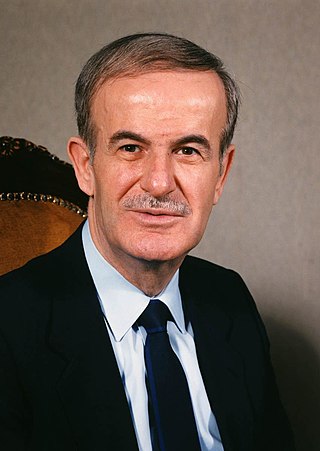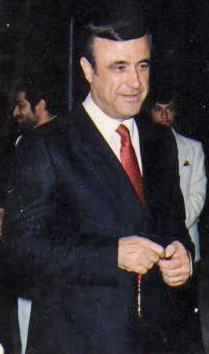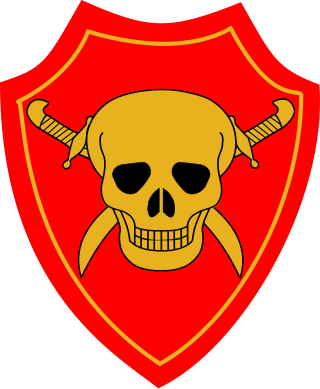
The Syrian Arab Armed Forces are the military forces of the Syrian Arab Republic. They consist of the Syrian Army, Syrian Air Force, Syrian Navy, Syrian Air Defense Force, and paramilitary forces, such as the National Defence Forces. According to the Constitution of Syria, the President of Syria is the Commander-in-Chief of the Armed Forces. Minister of Defense holds the position of Deputy Commander-in-Chief of the Army and Armed Forces.

Hafez al-Assad was a Syrian statesman, military officer and revolutionary who served as the 18th president of Syria from 1971 until his death in 2000. He had previously served as prime minister of Syria from 1970 to 1971 as well as regional secretary of the regional command of the Syrian regional branch of the Arab Socialist Ba'ath Party and secretary general of the National Command of the Ba'ath Party from 1970 to 2000. Hafez al-Assad was a key participant in the 1963 Syrian coup d'état, which brought the Syrian regional branch of the Arab Socialist Ba'ath Party to power in the country.

Rifaat Ali al-Assad is the younger brother of the late President of Syria, Hafez al-Assad, and Jamil al-Assad, and the uncle of the incumbent President Bashar al-Assad. He was the commanding officer of the ground operations of the 1982 Hama massacre ordered by Hafez al-Assad.

The Syrian Army, officially the Syrian Arab Army, is the land force branch of the Syrian Armed Forces. It is the dominant military service of the four uniformed services, controlling the most senior posts in the armed forces, and has the greatest manpower, approximately 80 percent of the combined services. The Syrian Army originated in local military forces formed by the French after World War I, after France obtained a mandate over the region. It officially came into being in 1945, before Syria obtained full independence the following year.

The Syrian Republican Guard, also known as the Presidential Guard, is an elite 25,000 man unit, although it may actually approach corps size with around 60,000 guardsmen. It is composed of two mechanized divisions. Its main purpose is to protect the capital of Syria, Damascus, from any foreign or domestic threats. The Guard was the only Syrian military unit allowed within the capital before the civil war. It is designed to defend the President of the Republic as well as the major presidential and strategic institutions, including the presidential palaces.

The Air Force Intelligence Directorate is an intelligence service of Syria, possibly the country's most powerful, owing its importance to Hafez al-Assad's role as the Air Force commander. Despite its name, it is mainly involved with issues other than air force intelligence, and took an active part in the suppression of the Muslim Brotherhood rebellion in the 1980s. Agents of this service have frequently been stationed in Syrian embassies or branch offices of the national airline.

The Brigades for the Defense of the Revolution, commonly referred to as Defense Companies, Defense Corps or Defense Brigades were an all-Alawite paramilitary force in Syria that were commanded by Rifaat al-Assad. Their task was to defend the Assad government, and Damascus, from internal and external attack.
The 1981 Hama massacre was an incident in which over 300 residents of Hama, Syria, were killed by government security forces.

The Free Syrian Army is a big-tent coalition of decentralized Syrian opposition armed militias in the Syrian Civil War founded on 29 July 2011 by Colonel Riad al-Asaad and six officers who defected from the Syrian Armed Forces. The officers announced that the immediate priority of the Free Syrian Army was to safeguard the lives of protestors and civilians from the deadly crackdown by Bashar al-Assad's security apparatus; with the ultimate goal of accomplishing the objectives of the Syrian revolution, namely, the end to the decades-long reign of the ruling al-Assad family. In late 2011, the FSA was the main Syrian military defectors group. Initially a formal military organization at its founding, its original command structure dissipated by 2016, and the FSA identity has since been used by various Syrian opposition groups.

The modern history of Syria begins with the termination of Ottoman control of Syria by French forces and the establishment of the Occupied Enemy Territory Administration during World War I. The short-lived Arab Kingdom of Syria emerged in 1920, which was however soon committed under the French Mandate, which produced the short-lived autonomous State of Aleppo, State of Damascus, Alawite State and Jabal al-Druze (state); the autonomies were transformed into the Mandatory Syrian Republic in 1930. Syrian Republic gained independence in April 1946. The Republic took part in the Arab-Israeli War and remained in a state of political instability during the 1950s and 1960s.

The 4th Armoured Division is an elite formation of the Syrian Army whose primary purpose is to defend the Syrian government from internal and external threats. The division is considered one of the most combat-ready formations of the Syrian Arab Army. It played a key role in some battles of the Syrian Civil War.

The 15th Special Forces Division is a division of the Syrian Armed Forces specializing in light infantry operations, based in the As-Suwayda Governorate. The Division is part of the Syrian Army's 1st Corps.

Homs Military Academy is a military educational and training institution located in Homs, Syria.

The National Defence Forces is a pro-Syrian government militia, that was formed on 1 November 2012 and organized by the Syrian government during the Syrian Civil War as a part-time volunteer reserve component of the Syrian Armed Forces.

The 1st Armoured Division is an armored division of the Syrian Arab Army. It was established in 1970 and is part of the 2nd Corps. The 1st Division is the largest formation of the Syrian Arab Army.
Ali Haydar, known as the "Father of the Syrian Special Forces", was a Syrian military officer who was the commander of the Syrian Special Forces for 26 years. He was a close confidant to President Hafez al-Assad and one of the members of Assad's inner circle. Born in the village of Hallet Ara, Haydar was a member of the Ba'ath Party from his youth. He was commissioned into the Syrian Army in 1952 after a stint studying at the Homs Military Academy. After the Ba'ath Party seized power in a 1963 coup d'état, Haydar was put in charge of Syria's special forces and supported al-Assad in his rise to the presidency. During this time he was deployed to Lebanon during their civil war. Haydar opposed the 1984 coup d'état attempt led by Rifaat al-Assad, instead remaining loyal to Hafez al-Assad. After suffering an aneurysm and leaving his post in 1988, he returned to lead the special forces again in the early 1990s. At the time a Major General, he was formally removed from his position and then imprisoned in August 1994, though he was treated well during his brief prison stay and was released without a trial or public humiliation. Haydar died in Latakia at the age of 90.

The 3rd Armoured Division is a formation of the Syrian Army responsible for securing the northern approach to Damascus. The division is based in a military complex near Qutayfah and has traditionally been seen as one of the Syrian Armed Force's most reliable conventional divisions. The division is part of the 3rd Corps.
The Struggle Companies was a 5,000-strong commando force deployed around Damascus. Created in 1973 and commanded by Maj. Gen Adnan Assad, a cousin of the late Syrian president, Hafez Assad. The all Alawite Struggle Companies are broadly similar to the Defense Companies and were fanatically loyal to the Syrian government and were heavily used during the 1982 Hama Muslim Brotherhood uprising

The 2nd Corps is a corps of the Syrian Army that was first formed in 1985. Richard Bennett wrote in 2001 that "three corps [were] formed in 1985 to give the Army more flexibility and to improve combat efficiency by decentralising the command structure, absorbing at least some of the lessons learned during the 1982 Lebanon War." He said that the 2nd Corps with HQ in Zabadani, covered north of Damascus, whole Homs and included Lebanon. In November 2019, Major General Abdul Majeed Ibrahim was appointed as commander of the 2nd Army Corps of the Syrian Arab Army.

The 3rd Corps is a corps of the Syrian Army that was first formed in 1985. Richard Bennett wrote in 2001 that "three corps were formed in 1985 to give the Army more flexibility and to improve combat efficiency by decentralising the command structure, absorbing at least some of the lessons learned during the 1982 Lebanon War." The 3rd Corps HQ was in Aleppo, based in the north and covered Hama, the Turkish and Iraqi borders, the Mediterranean coastline and was tasked with protecting the complex of chemical and biological warfare and missile production and launch facilities. On 30 December 2023, Major General Ahmed Moalla was named as commander of the 3rd Corps.













